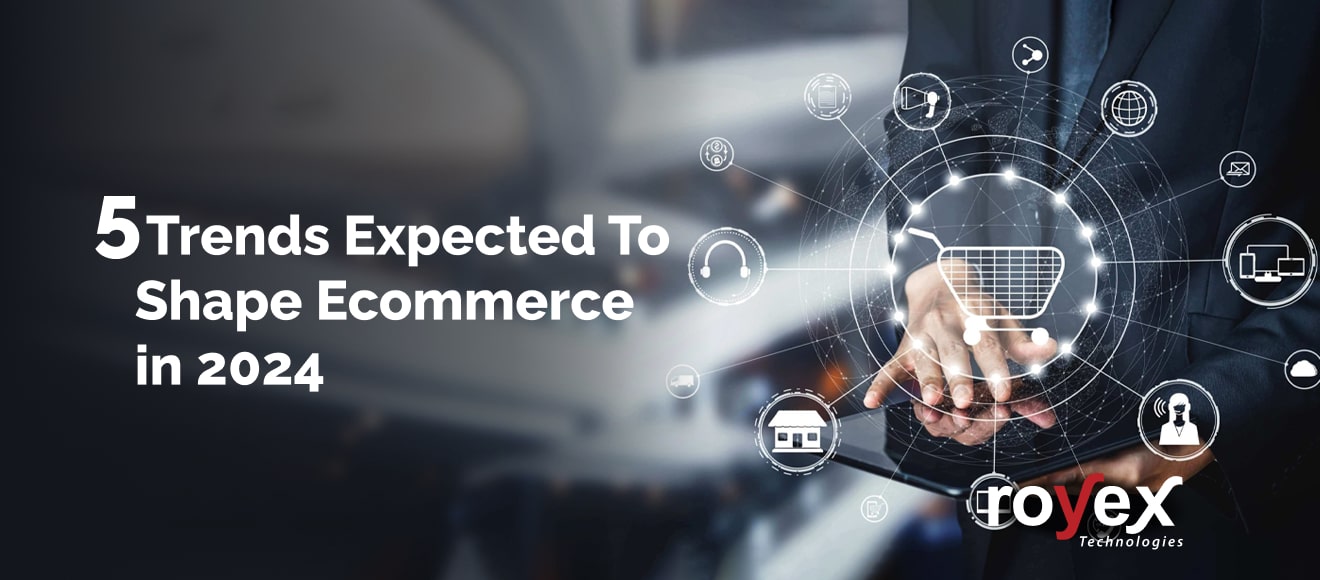
5 Trends Expected To Shape Ecommerce in 2024
The world of ecommerce is a dynamic and ever-evolving landscape, with innovations and trends reshaping the way businesses connect with consumers. As we stand on the brink of 2024, several exciting trends are poised to take center stage, influencing the future of online retail. In this article, we delve into the five key trends that are expected to shape the ecommerce landscape in the coming year.
Rise of Voice-enabled Commerce

With the rising popularity of virtual assistants and smart speakers, voice commerce is projected to become a major player in the ecommerce realm. In 2024, more consumers will embrace the convenience of using voice commands to browse, select, and purchase products. Ecommerce platforms will need to optimize their systems for voice searches, providing a seamless and efficient shopping experience for users.
In the grand scheme of things, we are just at the dawn of a new era where consumers are utilizing voice commands for online searches and shopping, even though some individuals still harbor reservations. Despite the fact that voice technology and voice assistants are not recent innovations, the integration of voice commerce has been a gradual and consistent process.
While the user base may be relatively small, customer satisfaction levels are remarkably high, with 80% of users expressing contentment with their voice commerce experiences. This presents an opportunity to enhance satisfaction for both B2B and B2C customers, as voice commerce stands to become a crucial element in the purchasing journey.
Despite the slow initial adoption, the outlook for digital voice commerce appears promising. The proliferation of voice-based assistants over the past decade, including platforms such as Amazon Alexa, Google Home, and Siri, has contributed to a concurrent surge in consumer interest in adopting voice commerce.
Projections indicate that global sales of these voice-enabled devices are poised to surpass $30 billion by the year 2024. The United States is expected to play a significant role in this trend, with estimates suggesting that approximately 55% of American households will likely have a smart speaker by 2024. Strategically optimizing for voice-enabled commerce at present will position businesses favorably for the imminent inevitability of this transformative shift.
ML and AI enabled eCommerce

Artificial Intelligence (AI) and Machine Learning (ML) are set to play a pivotal role in delivering personalized customer experiences. Ecommerce platforms will leverage AI algorithms to analyze user behavior, predict preferences, and tailor product recommendations. In 2024, expect a more refined and individualized shopping journey, enhancing customer satisfaction and loyalty.
Amazon has long acknowledged the advantages of leveraging artificial intelligence (AI) and related technologies. The colossal ecommerce giant utilizes machine learning to enhance product selection, user experience, and streamline logistics.
The impact of AI and machine learning on the ecommerce sector is profound, offering several key benefits for companies seeking to revolutionize their operations.
Enhanced Return on Investment (ROI)
Many are unaware of the extent to which AI can boost ecommerce sales. According to the McKinsey State of AI Report, a staggering 79% of respondents noted that integrating AI into marketing and sales has led to increased business revenue.
Concrete examples support this claim. Amazon's recommendation engine, powered by AI, drives an impressive 35% of the company's annual sales. Similarly, Alibaba experienced a 40% reduction in delivery errors after investing in its intelligent logistics program.
Targeted Marketing
The consolidation of data stands out as a primary benefit of AI in ecommerce. AI and machine learning can draw insights from diverse data sources within a business, breaking down silos and generating visible, accessible, and actionable insights. AI-driven Customer Data Platforms (CDPs) unify data, facilitating the analysis of large volumes of data and expediting the testing and refinement of marketing campaigns.
Informed Business Decisions
The challenge for many businesses lies not only in collecting data but also in making sense of it. Traditional analytics tools have served their purpose, but the integration of AI and ML in ecommerce takes it to a whole new level.
AI-driven predictive analytics, in particular, plays a crucial role. It enhances the precision of business decisions by accurately forecasting future demand patterns for specific products or entire categories within an ecommerce store.
Optimized Logistics and Inventory Management
Managing inventory poses significant challenges for both B2B and B2C operations, where stock levels can be either excessive or insufficient. Similar challenges apply to logistics, with retailers investing in efficient supply chain strategies to cut down on purchasing and manufacturing costs.
AI in ecommerce brings forth streamlined logistics and a transparent view of inventory. Advanced real-time inventory management systems, powered by AI, provide insights into inventory availability across warehouses and channels. These systems also leverage data analysis to predict demand patterns and optimize warehouse replenishment plans.
Social Commerce

Social media platforms have become more than just communication channels; they are evolving into powerful ecommerce hubs. In 2024, the integration of social commerce will deepen, allowing users to seamlessly discover and purchase products without leaving their favorite social apps. Ecommerce businesses will need to harness the potential of social platforms to connect with their audience and drive sales.
Anticipated figures project that social commerce retail earnings in the United States will soar to nearly $80 billion by 2025. With a staggering 4.59 billion people, constituting 57% of the global population, currently engaged in social media, leveraging social commerce becomes an obvious choice for brands aiming to broaden their reach.
The increasing popularity of social commerce can be attributed to its more convenient and interactive shopping experience. Projections indicate that the global value of social commerce is poised to reach approximately $2.9 trillion by 2026.
Distinguishing itself from traditional social media marketing approaches, where shoppers view a brand's content and then transition to the brand's website for shopping, social commerce transforms social platforms like Facebook Shops and Instagram Shops into virtual storefronts.
The surge in social commerce can be correlated with the escalating use of social media. Recent studies reveal that the average social media user now spends around 15% of their waking hours on these platforms. Moreover, approximately 10% of US adults admit to having an addiction to at least one social media app.
Unlike the traditional approach of redirecting customers to an online store, social commerce brings the store directly to the customer, meeting them on their preferred social media platforms. Enabling customers to complete their purchases directly through social media eliminates unnecessary steps, streamlining the buying process and creating a more seamless journey for customers, ultimately translating into increased sales for retailers.
Furthermore, the mobile-friendly nature of social media platforms enhances the accessibility of social commerce, making it an effective and inclusive method for reaching diverse audiences.
Subscription-based pricing and membership programs

Subscription-based e-commerce represents a business model wherein customers pay a recurring fee to receive a product or service at regular intervals. This approach has witnessed a surge in popularity, offering companies the advantage of generating steady, predictable revenue while providing customers with the ease of use and predictability. Notable examples of subscription-based e-commerce include meal kit delivery services, monthly box subscriptions, and online streaming platforms.
From a business perspective, the steady income derived from subscription fees contributes to a stable financial foundation and simplifies sales forecasting. Moreover, subscription models serve as a means for businesses to stand out in a competitive market and cultivate a dedicated and loyal customer base.
For consumers, subscription-based models bring convenience and predictability to their purchasing experience. The need to place individual orders is eliminated, and subscribers often find cost savings compared to buying products or services individually. Additionally, these models can foster a sense of community or exclusivity among customers, with special discounts or perks commonly offered as part of their subscription packages.
The subscription-based e-commerce model has experienced remarkable growth in recent years, providing advantages for both businesses and customers alike. As we look ahead to 2024, the prominence of this model is poised to increase further. Customers stand to benefit from the seamless delivery of products and the chance to explore new offerings, while businesses can capitalize on the predictability of revenue and the establishment of enduring customer loyalty.
Q-Commerce

The advent of Q-commerce became particularly pronounced during the COVID-19 pandemic and has since exhibited steady growth. Projections indicate that it is poised to expand by 24% from 2020 to 2024, reaching an impressive $20 billion in the MENA region.
A significant portion of startups that emerged during the pandemic focused on Q-commerce, and their presence is expected to continue growing, establishing a notable market share within the eCommerce industry.
Q-commerce presents a unique value proposition for businesses, setting them apart from competitors. The immediacy of delivery appeals to customers seeking swift solutions, making them more inclined to explore new products and order from unfamiliar stores.
The enhanced convenience offered by quick commerce serves as a strategic tool for online retailers to compete not only with major multinational marketplaces like Amazon but also with traditional brick-and-mortar establishments. Embracing Q-Commerce services can be a key differentiator for businesses, especially in sectors where speed plays a crucial role in decision-making.
Businesses that integrate Q-Commerce often implement real-time inventory tracking systems, optimizing stock levels and averting potential out-of-stock scenarios. Beyond swift product delivery, Q-Commerce focuses on meeting and exceeding expectations, fulfilling promises, and ensuring a seamless, hassle-free transaction experience. It effectively bridges the gap between consumer desire and fulfillment within a matter of hours, showcasing that the journey from browsing to ownership can be as immediate as a simple tap on a screen.
Why Choose Royex Technologies For Ecommerce Development?
Royex Technologies is a leading e-commerce development company in Dubai. If you plan to design/redesign your website or launch an e-commerce platform, our 24*7 technical teams will give you design and development support. Let Royex’s web development team help develop your e-commerce store to drive more qualified visitors to your site and convert those visitors into leads and sales.
Check our portfolio to see our previous works. Contact us via email at info@royex.net or call us at +971566027916. To get started with us.




